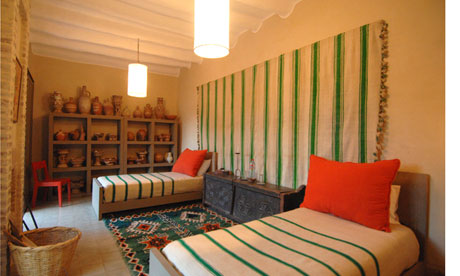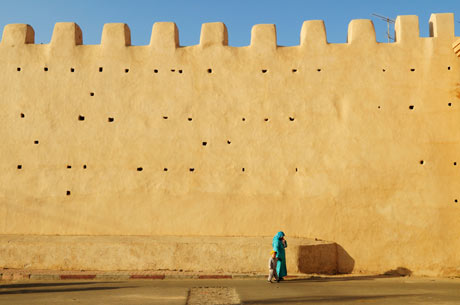Travel
A hotel with stunning gardens in the medieval town of Taroudant in southern Morocco is a riad in the true sense of the word

Gavin McOwan | The Guardian
Let’s get one thing straight – this is a riad. Forget all those Marrakech hotels with their measly courtyards – they’re not proper riads. I’ve barely set foot inside the Dar al Hossoun and the owner, Ollivier Verra, who is giving me a tour of the amazing hotel gardens, can’t resist a little dig at Taroudant’s more famous neighbour.
“All those trendy hotels in Marrakech are not riads,” says Ollivier, “they’re medina townhouses. Riad means garden in Arabic [in the strictest sense of the word] and most of them don’t have gardens. But why call yourself a maison when riad sounds so much more exotic, right?”
Absolutely right if you happen to be the owner of one of the most stunning “riads” in the whole of Morocco. For the desert gardens at Hossoun, in the ancient town of Taroudant in southern Morocco, are truly unique. They contain more than 900 different species of plants collected from all over the world – mainly succulents, aloes, palm trees and cacti that can adapt to a desert environment where rainfall has dropped to 100mm a year over the last decade. Wandering through the labyrinth of connected courtyards, which have been semi-landscaped over 15 acres of a former olive grove, you come across a new garden at every turn. It’s like the desert conservatory at Kew Gardens with the roof off, a collection of rare plants from Madagascar, Mexico, the Middle East and South America added to indigenous Moroccan species, and forms a spectacular and incredibly peaceful setting for this small hotel. On a clear day you can see the snow-capped High Atlas mountains from the roof terrace.
The main courtyard is bursting with large cacti, euphorbia, tropical grasses, jacaranda and palm trees, and through its heart runs a “line of water”, a long narrow swimming pool (just 3m wide by 29m long), inspired by the Alhambra in Granada, which creates a dramatic counterpoint to the garden. Four resident peacocks add a regal touch.
The gardens are so imposing that the series of single-storey bedrooms, sitting rooms and the hammam that frame them are inevitably overshadowed by all the greenery, yet they are equally original in conception.
Both house and garden are the creations of Arnaud Maurières and Eric Ossart, two French globetrotting botanists, plant hunters, architects and art and craft collectors.
One day, the pair were walking in the Atlas mountains and came across local builders making a house out of rammed earth. They were so impressed with the work they asked the builders to come and make a house for them at Hossoun, and then learned how to do it themselves. They obviously got the knack of it, as several architectural commissions soon followed – including one for their neighbour, the former empress of Iran, who wanted her residence built with rammed earth, but in a traditional Persian style.
All the rooms in the hotel are these traditional structures with thick earth walls that provide insulation against the heat and the cold. The only concessions to modern architecture are the large picture windows that connect the houses to the gardens.
Outside my window is a large courtyard featuring a deep sunken garden within the quarry of earth created to build the houses. It is sheltered, slightly cooler and more humid down there, so ideal for banana and papaya trees as well as the Brazilian potato tree and Mexican desert willow. From outside the sunken garden, you peer down on the treetops as if looking down into a tiny valley.
The rooms are stylish but understated, the earth walls and surfaces painted in natural white or muted earthy browns to complement the architecture. When Ollivier bought the house a couple of years ago, he was smart enough to purchase the rich collection of artefacts that the previous owners had built up from a decade of travelling, so the place is simply but beautifully adorned with Mediterranean pottery and rare Middle Eastern carpets, as well as locally made furniture. Two of the stand-out pieces are a long stretch of an antique Berber tent that fills a wall in the sitting room and the tall warped wooden pillars from a mosque in southern Morocco that date back to the 18th century.
Housson fulfils the role of a riad perfectly: a private house that is a world within a world and attends to your every whim. It is so relaxing that it was an effort to leave the hotel, and I was content to laze in the gardens, swim a few lengths of the pool and wait for homemade delights to come out of the kitchen.
The hotel’s food is pan-Mediterranean rather than pure Moroccan: one day we had a Lebanese lunch of fresh homemade hummus, babaghanoush and tabbouleh,along with salads of homegrown leaves and raw papaya; another day it was a mixed platter of delicious fried fresh seafood.
One day Ollivier did manage to drag me for a walk in the Anti-Atlas mountains, an hour’s drive away. We didn’t see another soul as we walked up a dry, boulder-strewn valley, the sides so steep we were sheltered from the sun. But on the way down we met Aisha, a lovely Berber woman who invited us in for mint tea, figs and biscuits, and showed us round her rambling old house.
Another day I took one of the hotel’s bikes into Taroudant, a couple of miles away, and explored the souks inside the high, crenellated terracotta ramparts of the medieval city billed as the grandmother of, or mini Marrakech. As a first-time visitor to Morocco, I’m not sure how accurate that description is, but for someone who speaks little French and had always been slightly wary of the country’s reputation for giving tourists a run for their money, I found Taroudant the perfect introduction to the country. I walked around the city’s two rambling souks without any bother; most stallholders would smile when I entered their shop, leave me to browse alone, and smile again as I left.
Taroudant has a small, arty expat community who prefer the easy-going authenticity of the town to the excesses of Marrakech, or “Paris’s 21st arrondissement”, as one them bitchily described it. I was lucky enough to get a peek inside one of their houses – an amazing Aladdin’s cave over several uneven floors with fine artwork and a roof terrace literally on top of the ramparts – and guessed it won’t be long before such places open up as riad hotels (in the looser sense of the word, of course). The King of Morocco has given the town the royal seal of approval and is currently building a house here.
My guess is that Taroudant is much sleepier than Marrakech – more of a little sister than a grandmother – but the impressive rammed-earth ramparts, winding souks and lively street cafes, plus the lack of tourists, make it a fascinating place to wander around for a day or two.
I don’t think many people would come to Morocco just to visit Taroudant – although it is doable for a long weekend as the town is less than an hour from Agadir airport. Most visitors use Taroudant in the same way it has been used for centuries, as a stop on the caravan route, a place where the desert meets the Atlas mountains, en route to Marrakech to the north over the stunning Tizi‑n‑Test Pass, the Sahara to the south and the Atlantic coast to the west.
And, as a place to stop and rest, the paradise garden of Dar al Hossoun is about the most peaceful place you could ever wish to find.






